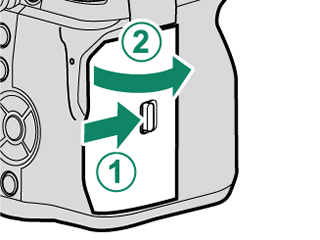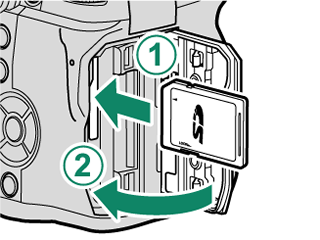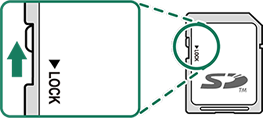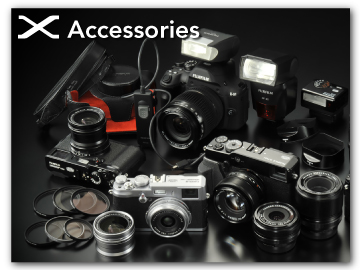Inserting Memory Cards
Pictures are stored on memory cards (sold separately).
The camera is equipped with two memory card slots. Use Slot 1 with CFexpress cards and Slot 2 with SD, SDHC, or SDXC cards.
-
Open the memory card slot cover.
Unlatch and open the cover.

Do not turn the camera off or remove the memory card while the memory card is being formatted or data are being recorded to or deleted from the card. Failure to observe this precaution could damage the card.
-
Insert the memory card.
Holding the card in the orientation shown, slide it in until it clicks into place at the back of the slot. Close and latch the memory card slot cover.

Be sure card is in the correct orientation; do not insert at an angle or use force.
Removing Memory Cards
Turn the camera off and open the memory card slot cover. Eject the card by pressing it in with a finger and then slowly releasing it; the card can then be removed by hand.

Press the center of the card.
Suddenly removing your finger from the card could cause the card to fall from the slot. Remove your finger slowly.
If the camera displays a p icon, the memory card may be hot to the touch. Wait for the card to cool before removing it.
Using Two Cards
The camera can be used with two cards, one in each of its two slots. At default settings, photos are saved to the card in the second slot only when the card in the first slot is full. This can be changed using DSAVE DATA SET-UP > xCARD SLOT SETTING.
| Option | Description | Display |
|---|---|---|
| SEQUENTIAL (default) |
The card in the second slot is used only when the card in the first slot is full. If the second slot is selected for DSAVE DATA SET-UP > SELECT SLOT(x SEQUENTIAL), recording will start on the card in the second slot and switch to the first slot when the card in the second slot is full. |  |
| BACKUP | Each picture is recorded twice, once to each card. |  |
| SEPARATE | RAW pictures are recorded to the card in the first slot and JPEG or HEIF pictures to the card in the second slot. This setting takes effect only when FINE+RAW or NORMAL+RAW is selected for HIMAGE QUALITY SETTING > IMAGE QUALITY. |  RAW+JPEG |
 RAW+HEIF |
The card used to store movies can be selected using BMOVIE SETTING > MEDIA REC SETTING.
Compatible Memory Cards
- The camera can be used with SD, SDHC, SDXC, and CFexpress Type B memory cards. Both the UHS-I and UHS-II bus interfaces are supported.
- CFexpress or UHS-II memory cards are recommended for high-speed burst photography.
- The types of memory cards suitable for movie recording vary with the settings selected (aAdjusting Movie Settings).
- A list of supported memory cards is available on the Fujifilm website. For details, visit: COMPATIBILITY (cameras).
Do not turn the camera off or remove the memory card while the memory card is being formatted or data are being recorded to or deleted from the card. Failure to observe this precaution could damage the card.
Memory cards can be locked, making it impossible to format the card or to record or delete images. Before inserting a memory card, slide the write-protect switch to the unlocked position.

Memory cards are small and can be swallowed; keep out of reach of children. If a child swallows a memory card, seek medical assistance immediately.
miniSD or microSD adapters that are larger or smaller than memory cards may not eject normally; if the card does not eject, take the camera to an authorized service representative. Do not forcibly remove the card.
Do not affix labels or other objects to memory cards. Peeling labels can cause camera malfunction.
Movie recording may be interrupted with some types of memory card.
Formatting a memory card in the camera creates a folder in which pictures are stored. Do not rename or delete this folder or use a computer or other device to edit, delete, or rename image files. Always use the camera to delete pictures; before editing or renaming files, copy them to a computer and edit or rename the copies, not the originals. Renaming the files on the camera can cause problems during playback.

 .
.


